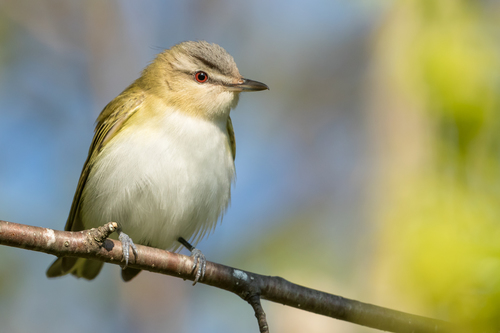
Red-eyed Vireo
The Red-eyed Vireo (Vireo olivaceus) is a small, yet highly vocal songbird common throughout North and South America. Known for its persistent singing, even during the hottest parts of the day, it plays a crucial role in controlling insect populations within its forest habitats. While not particularly flashy in appearance, its ruby-red eyes are a distinctive feature for those who get a close look. This species holds no specific cultural significance, but it is a welcome sign of a healthy ecosystem.
12-14 cm
Length
23-25 cm
Wingspan
Least Concern
Conservation Status
Distribution
Breeds across much of Canada and the eastern and northwestern United States. Winters in South America, primarily in the Amazon basin. Migrates through Central America and the Caribbean.
Lifespan
Up to 10 years in the wild, though typically shorter.
Red-eyed Vireo's Habitat
Habitat Types
Deciduous forests, Mixed woodlands, Forest edges, Parks and gardens with mature trees
Climate Zones
Temperate, Tropical
Adaptations
Their slightly hooked bill is adapted for gleaning insects from foliage. Their migratory behavior allows them to exploit seasonally abundant food resources.
Variations
Several subspecies are recognized, differing slightly in plumage and size, with some residing year-round in South America (e.g., *V. o. chivi*).
Appearance
Breeding Plumage
Generally similar year-round.
Seasonal Feather Changes
Minimal, some individuals may appear slightly brighter during breeding season.
Sex Based Plumage Differences
Males and females are visually similar.
Notable Features
Red eyes (in adults), Olive-green upperparts, White underparts, Gray crown with a white eyebrow stripe bordered by black
Diet and Feeding
Primary Foods
Insects, Spiders, Caterpillars, Berries (especially in fall and winter)
Foraging Behavior
Gleans insects from leaves and branches, often hanging upside down to reach prey. May also hover briefly to catch flying insects.
Specializations
Slightly hooked bill aids in capturing and manipulating insect prey.
Seasonal Diet Variations
Primarily insects during the breeding season; incorporates more fruits and berries into the diet during migration and winter.
Behavior
Social Structure
Generally solitary or in pairs during breeding season. May form small flocks during migration.
Communication
Persistent, repetitive song ('look up, in the tree, see me'), Chattering calls, Scolding calls when threatened
Migration
Long-distance migrant, traveling between North American breeding grounds and South American wintering grounds. Migrates at night.
Territorial or Group Behaviors
Males are highly territorial during the breeding season, defending their territory through song and chasing intruders.
Conservation
Threats
Habitat loss (both breeding and wintering grounds), Pesticide use (reducing insect prey), Collisions with buildings and other structures during migration, Climate change (potential shifts in habitat and food availability)
Protection Programs
Migratory Bird Treaty Act (protection in the US), Various habitat conservation initiatives
Local National Laws
Protected under various state and federal laws in the US and Canada.
Population Trend
Generally stable, although some regional declines have been noted.
Population Estimates
Global population estimated at around 180 million individuals.
Interesting Facts
Red-eyed Vireos are among the most frequent singers in the bird world.
Males can sing more than 20,000 songs in a single day during the breeding season.
They are known to be parasitized by Brown-headed Cowbirds.
Cowbirds lay their eggs in vireo nests, leaving the vireos to raise the cowbird chicks.
They undertake long migrations.
They fly thousands of kilometers between its breeding and wintering grounds.
Faqs about Red-eyed Vireo
What do Red-eyed Vireos eat?
They primarily eat insects, especially caterpillars, during the breeding season. They also eat berries and fruits, particularly during migration and winter.
Where do Red-eyed Vireos build their nests?
They build cup-shaped nests suspended from forked branches in trees, usually in deciduous forests.
Are Red-eyed Vireos endangered?
No, they are classified as Least Concern by the IUCN, meaning they are relatively common and widespread. However, some populations may be declining due to habitat loss and other threats.
How can I identify a Red-eyed Vireo?
Look for a small, olive-green bird with a white eyebrow stripe, a gray crown, and, in adults, red eyes. Listen for its persistent, repetitive song.
Copyright @ Nature Style Limited. All Rights Reserved.
 English
English